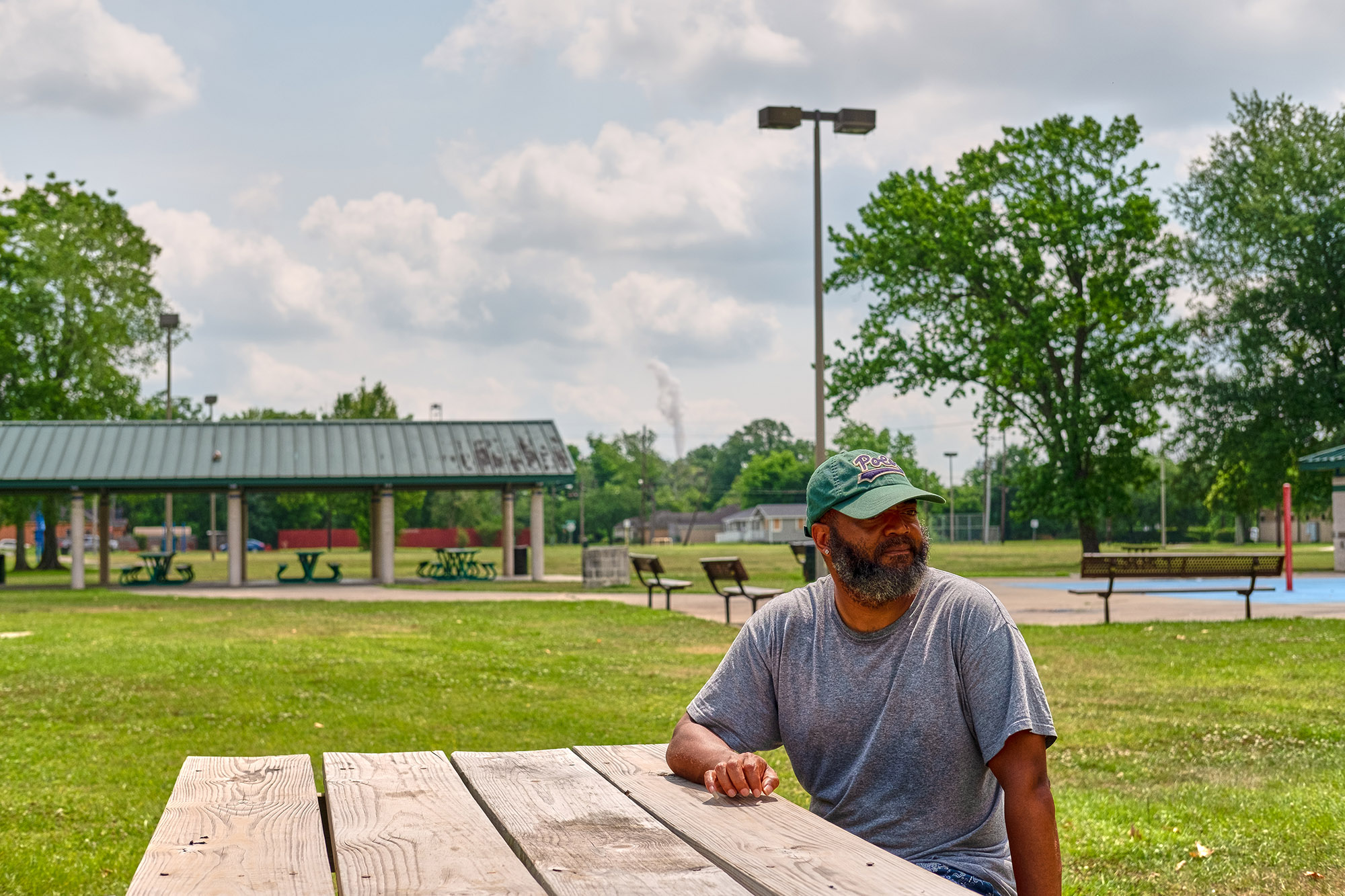
Christopher Jones, president of Charlton-Pollard Historical Neighborhood Association in Beaumont, Texas, sits at a park bench in his neighborhood May 17, 2022. In the background, a nearby oil refinery releases gas into the air.
Each year, hurricane season sweeps across the Atlantic June through November, and each year communities of color bear the brunt of the season’s devastating impacts. Hurricanes are common along the upper Texas Gulf Coast where residents of color face challenges related to equitable climate recovery and resilience.
In the wake of Hurricane Harvey making landfall and causing mass devastation in the area in 2017, the Institute for Sustainable Communities, the Coalition for Environment, Equity, and Resilience or CEER, and Texas Southern University teamed up to bring economic recovery and foster resilience in the region.
Together the three entities formed the Upper Texas Gulf Coast Resilience Initiative to improve the uneven disaster response practices that plague Gulf Coast communities’ ability to foster equitable recovery for all its residents.
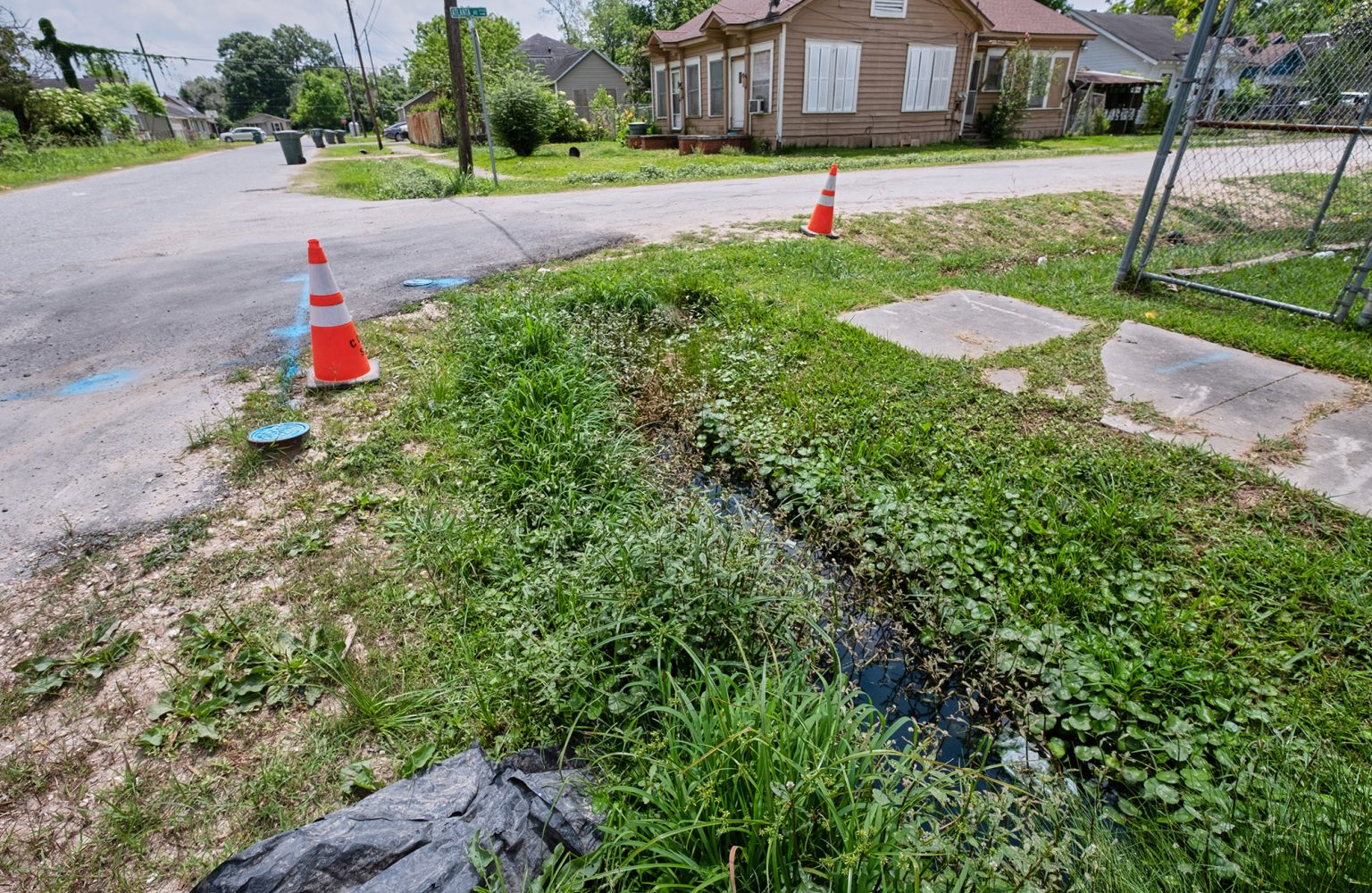
Safety cones mark an area of standing water and overgrown vegetation in a Beaumont, Texas, neighborhood May 17, 2022. Throughout the year, and especially during hurricane season, Beaumont residents face environmental hardships like flooding, sewage overflow, foul smells, air pollution from nearby oil refineries and a lack of recovery funding.
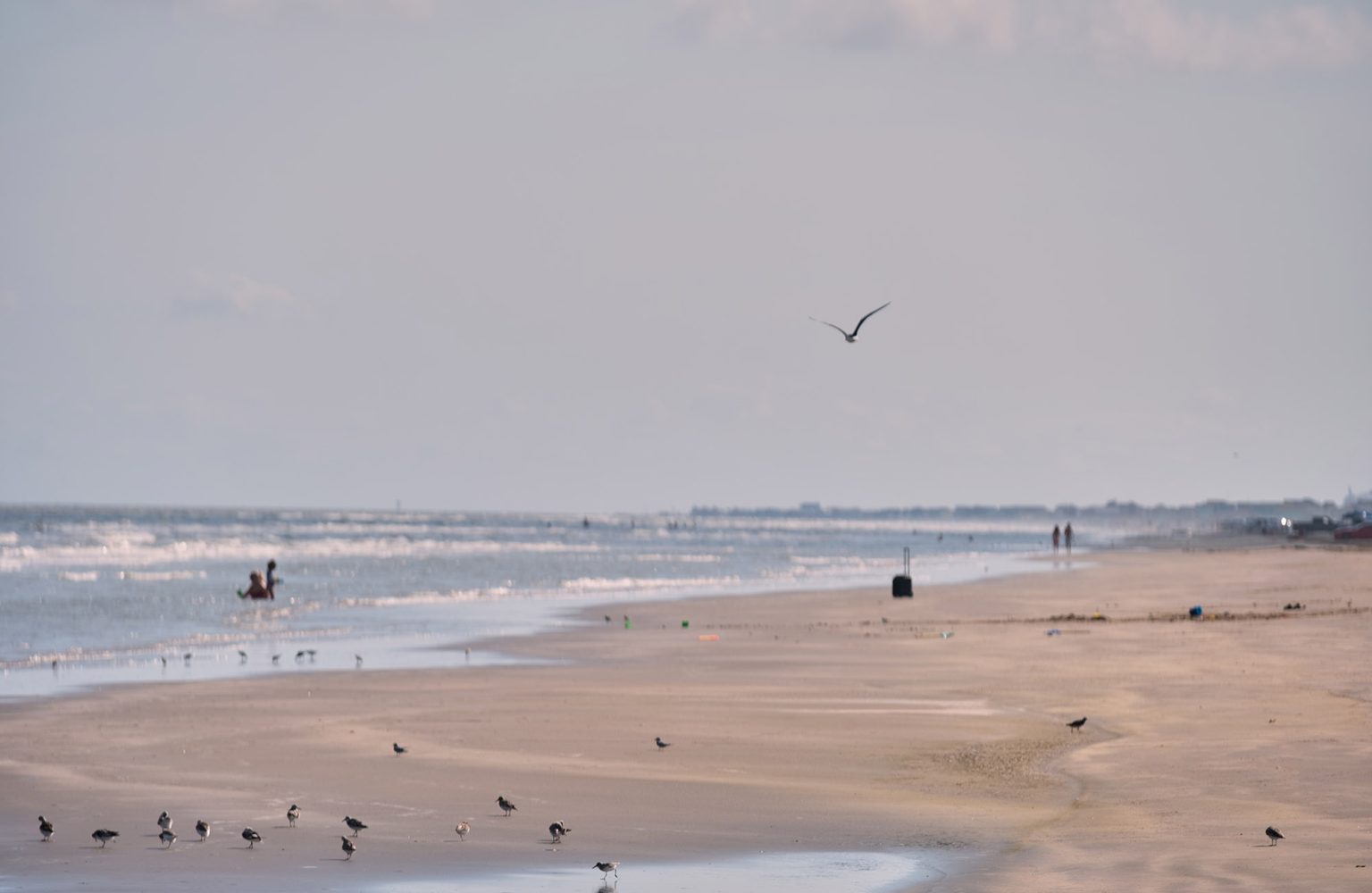
Birds gather along the cost of Follett’s Island Beach in Brazoria County in Texas, May 17, 2022. Each year, hurricane season brings devastating impacts to communities of color along the upper Texas Gulf Coast.
“What is so important about the work that we’re doing is we are talking to community members,” said Rashida Manuel, senior program officer at the Institute for Sustainable Communities. “We are amplifying their voices and giving them the opportunity to be co-creators in the solutions that are impacting their communities.”
Through cross-sector collaboration, the initiative hosted more than 20 diverse partners who worked across the project’s geography to bring statewide presence and influence, racial equity acumen and access to data and research.
Building Community Resilience
The Coalition for Environment, Equity, and Resilience plays a significant role in building community resilience in the upper Texas Gulf Coast. The coalition is an alliance of 28 member organizations across the state of Texas that address environmental justice and public health issues and the respective policy solutions that impact communities in the region.
Teresa Davis, interim coalition director of CEER, said pollutants are a big issue in the communities the organization serves and that often, residents do not have equitable ways to communicate the health and environmental issues they observe and experience.
“There’s no clear protocol for our community members to report what they see, what they smell and what they hear in their communities."
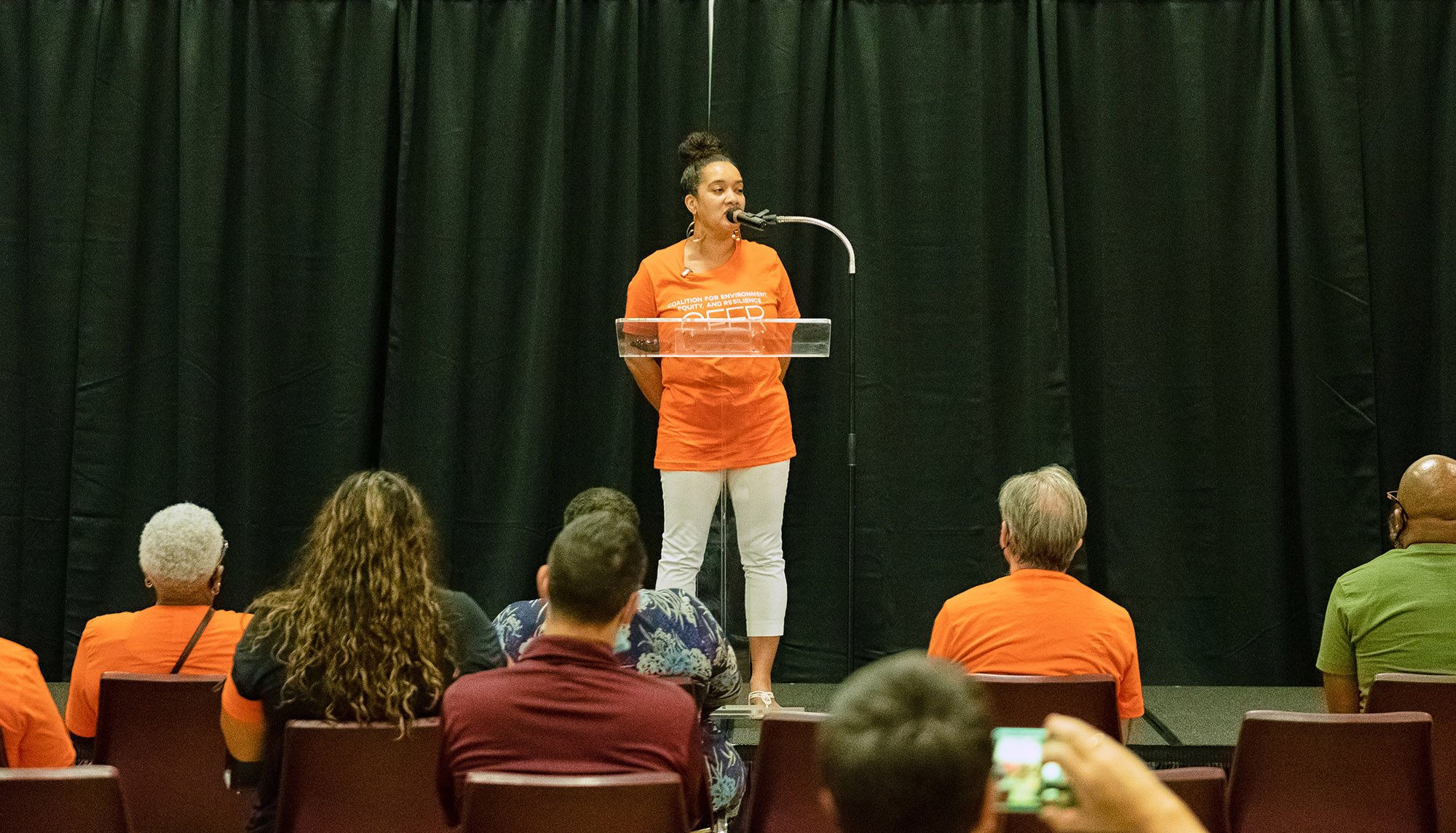
Teresa Davis, interim coalition director for the Coalition for Environment, Equity, and Resilience, speaks during the organization’s People’s Hearing at the Carl Walker, Jr. Multi Service Center in Houston, Texas, April 30, 2022.
“There’s no clear protocol for our community members to report what they see, what they smell and what they hear in their communities,” Davis said.
The coalition formed its regional resilience campaign to hold government agencies accountable for the funding, resources, two-way communication, and availability that those agencies promised to give their communities.
The campaign champions equitable recovery for all and addresses issues such as disaster-recovery funding, air pollution monitoring, and flooding.
Through its regional resilience campaign, the coalition engages community members to organize, raise their concerns and provide input during government decision-making processes to, in turn, influence policy at local and state levels.
Davis said the coalition has been building momentum around environmental justice issues. “The only way to do that is to go into these communities and to start having these conversations — to teach the language, to make the message relevant to them, to help them to connect the dots and understand the impacts of climate change and where there is a lack of equity when it comes to the climate issues.”
The organization held its People’s Hearing event on April 30, 2022, in Houston, Texas. One by one, community members addressed the Texas Commission on Environmental Quality, describing the health and environmental hardships plaguing their neighborhoods.
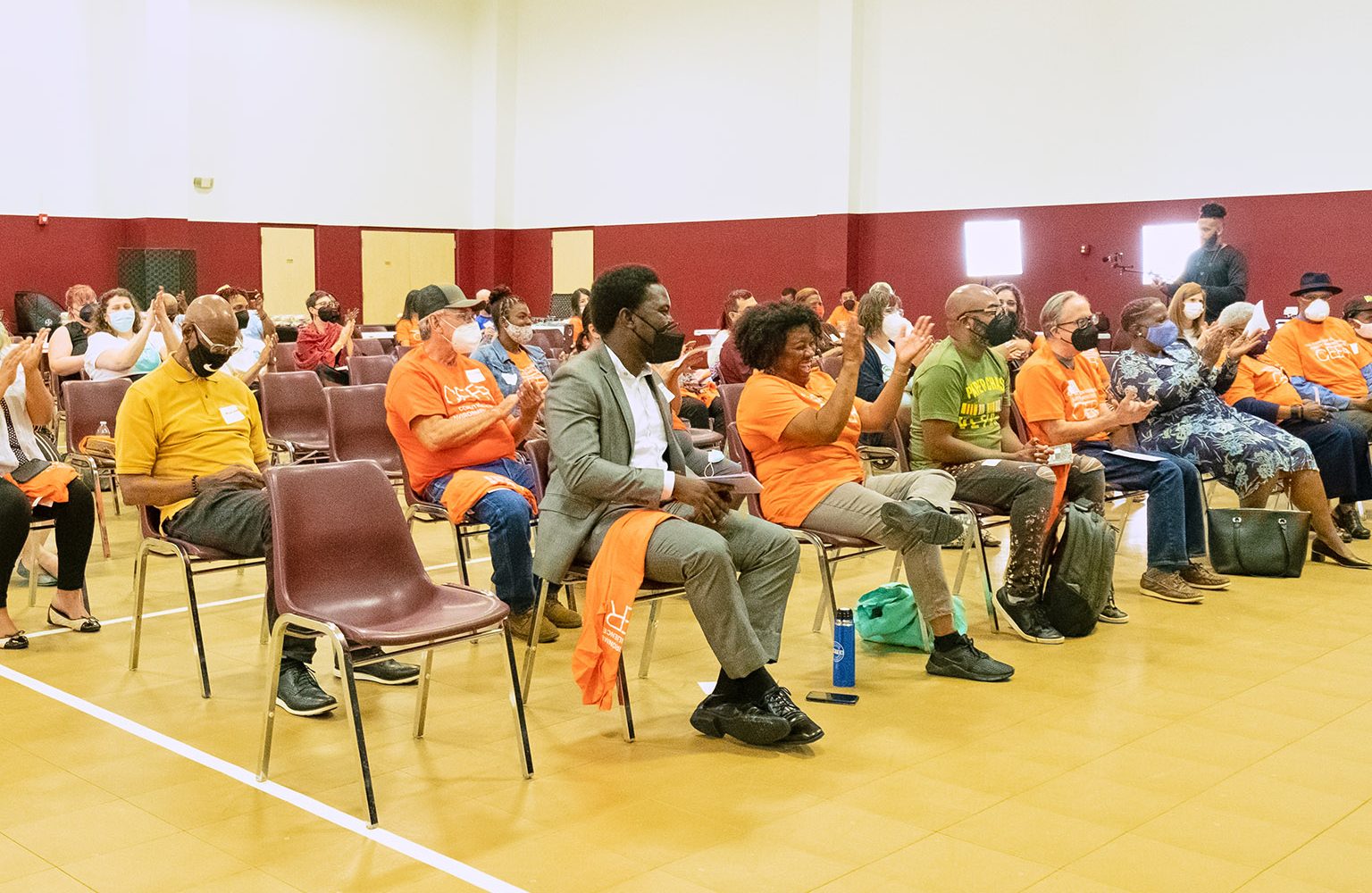
Attendees applaud speakers during the Coalition for Environment, Equity, and Resilience’s People’s Hearing event at the Carl Walker, Jr. Multi Service Center in Houston, Texas, April 30, 2022. The hearing gave community members an opportunity to voice the health and environmental hardships their neighborhoods face to the Texas Commission on Environmental Quality.
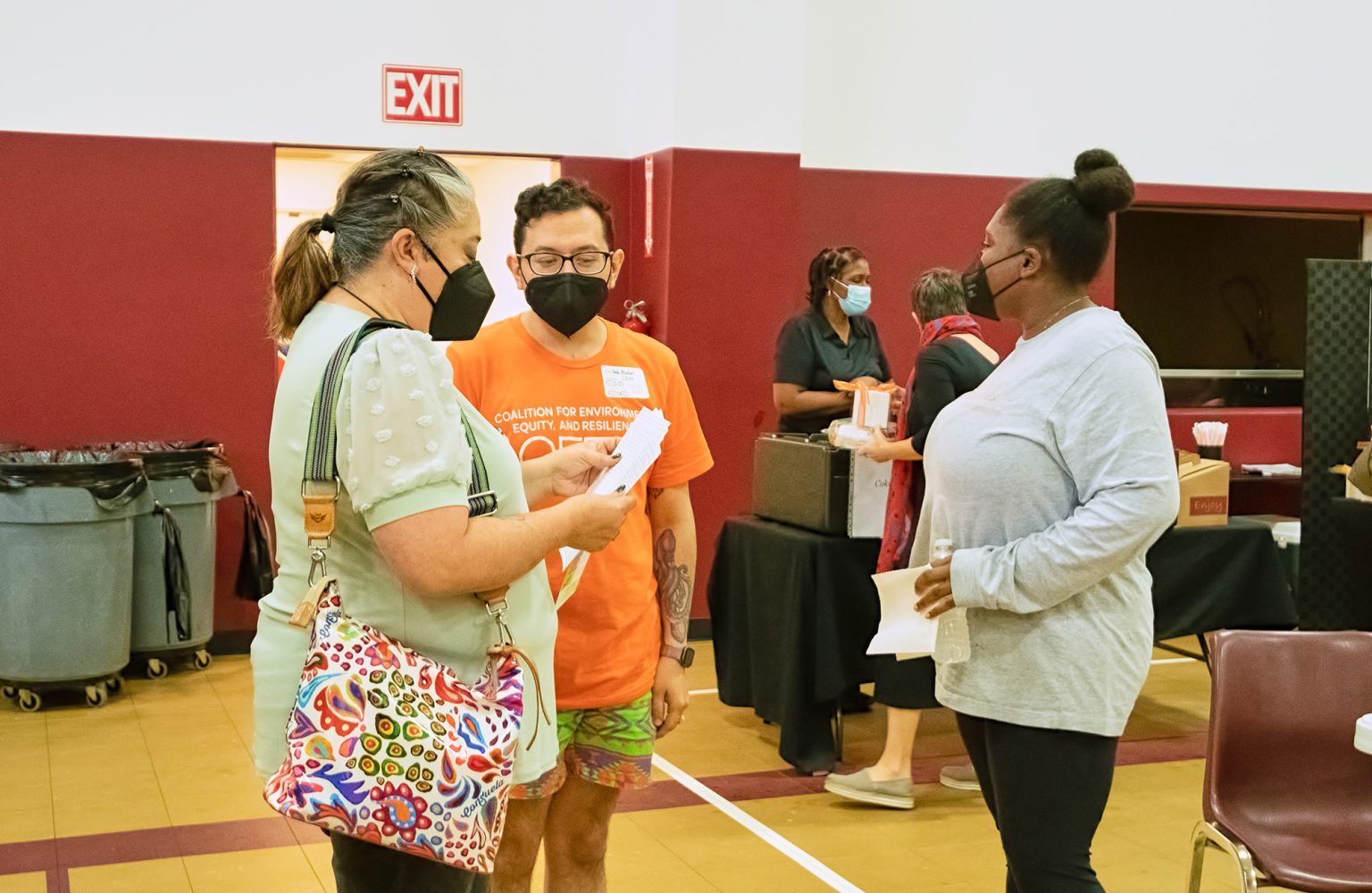
Andy Escobar, senior regional community organizer at the Coalition for Environment, Equity, and Resilience, and Cora Martin, program and research assistant at the Institute for Sustainable Communities, speak with an attendee at CEER’s People’s Hearing at the Carl Walker, Jr. Multi Service Center in Houston, Texas, April 30, 2022.
“Climate issues are real and we have, I know in my community, some very serious issues as it relates to pollution,” said Gayla Young, a Beaumont, Texas, resident and community organizer for the Coalition for Environment, Equity, and Resilience. She attended the People’s Hearing on April 30.
“We have bad odors all the time,” Young said. “It’s so bad sometimes it’ll wake you up out of your sleep. We have brown water. Our water has a smell — like literally as it comes out of the faucet you can actually smell it. And, it’s not just on this side of Beaumont or on that side of Beaumont, as it relates to water. It’s all over Beaumont.”
Christopher Jones, president of the Charlton-Pollard Historical Neighborhood Association, can sit at a community park in his Beaumont, Texas neighborhood and point to fumes a nearby oil refinery releases into the air.
Jones said his neighborhood suffers from air pollution, sewage overflow and flooding, making streets inaccessible.
He also said it’s often difficult for his neighbors to receive recovery resources after climate disasters like hurricanes Harvey and Ike.
“They can go through the process to fill out the application. It doesn’t necessarily mean that they’re going to be the recipients of those resources. To get those resources to individuals, inhabitants of my neighborhood, it’s like it’s intentionally neglected."
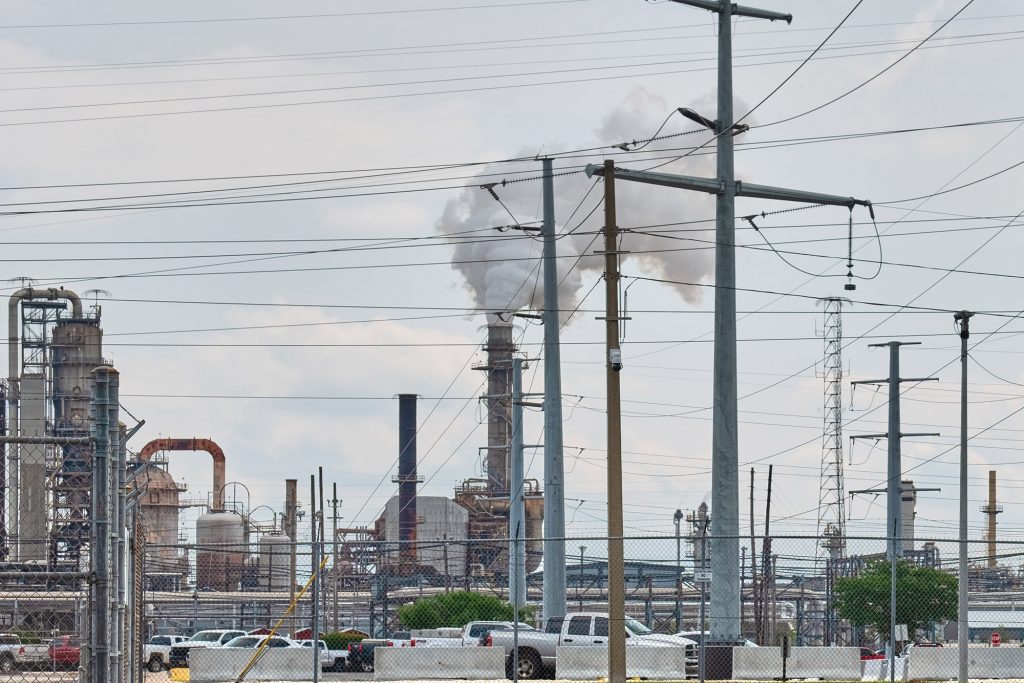
An oil refineries release gas into the air near the Santa Anna town site marker in Beaumont, Texas, May 17, 2022.
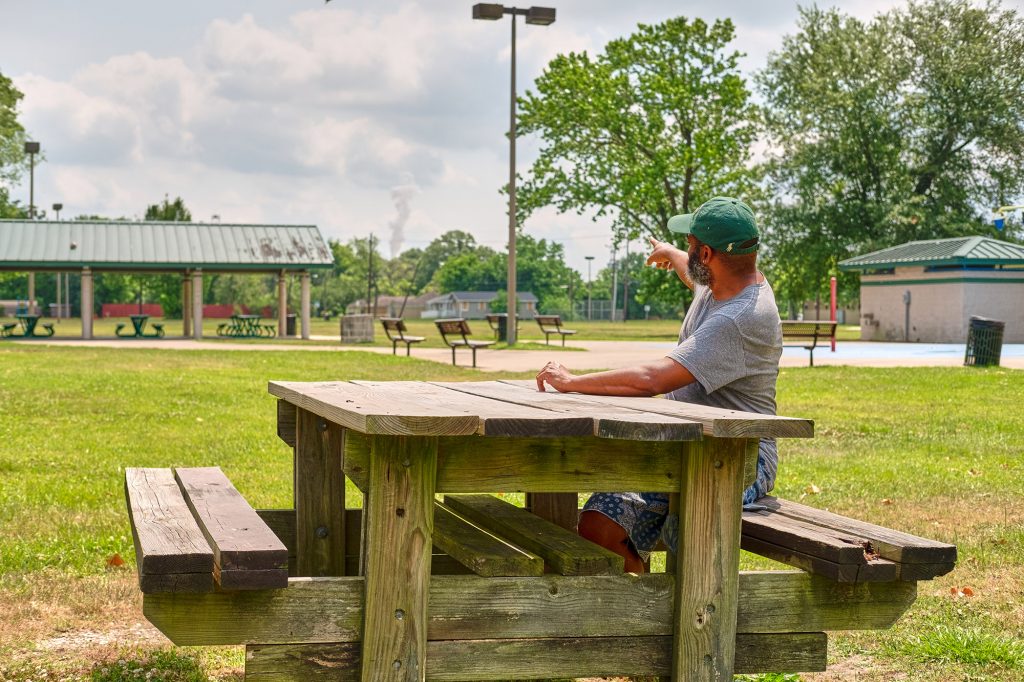
Christopher Jones, president of Charlton-Pollard Historical Neighborhood Association sits at a park bench in his Beaumont, Texas, neighborhood May 17, 2022. From that bench, Jones pointed point to gas a nearby oil refinery released into the air.
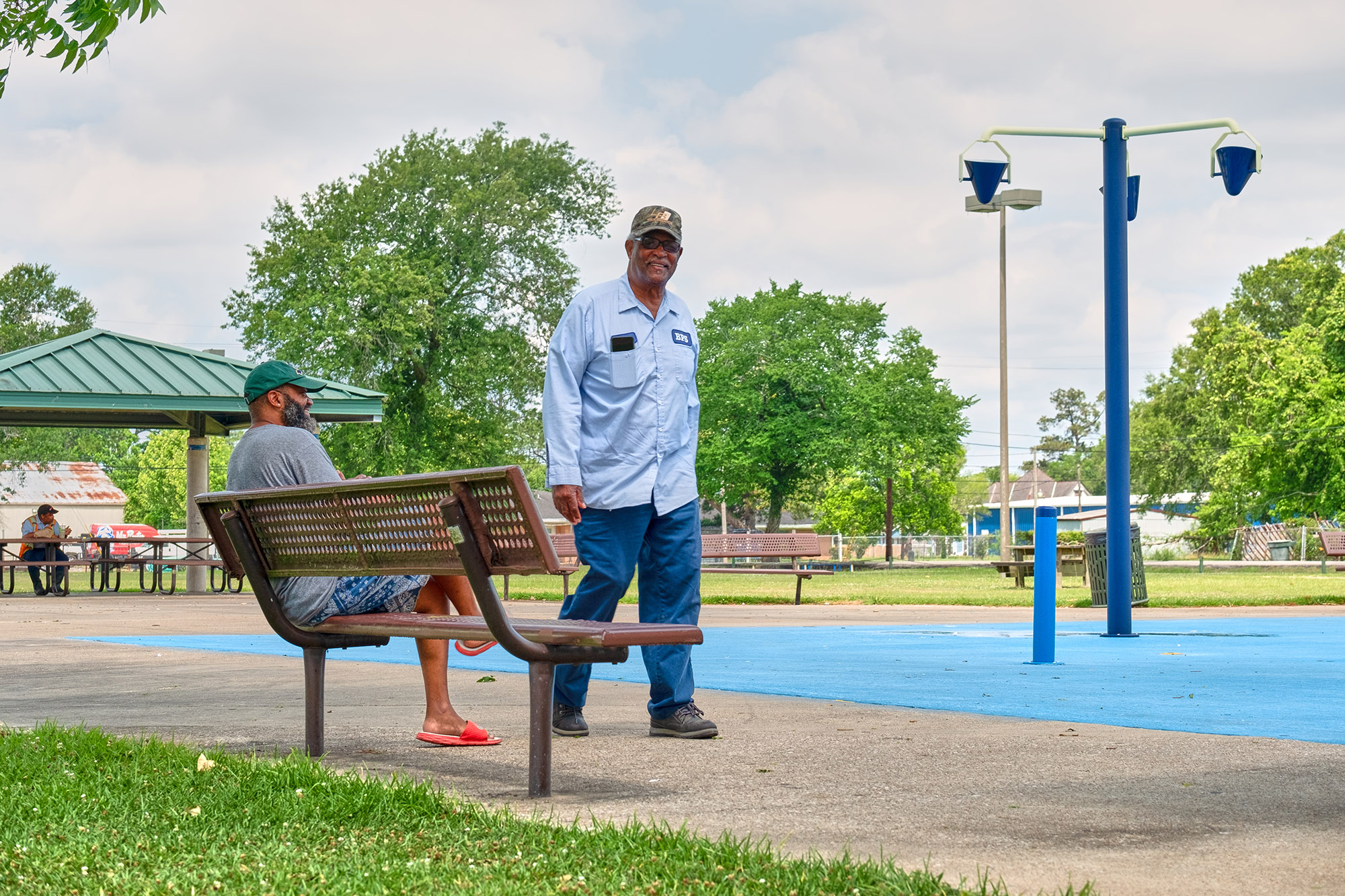
Christopher Jones, president of Charlton-Pollard Historical Neighborhood Association sits at a park bench as a neighbor passes by in his Beaumont, Texas, neighborhood May 17, 2022.
“They can go through the process to fill out the application,” Jones said. “It doesn’t necessarily mean that they’re going to be the recipients of those resources. To get those resources to individuals, inhabitants of my neighborhood, it’s like it’s intentionally neglected.”
Jones said it was his business to understand the environmental and public health issues his community faces so he can stay aware and share that information with his neighbors.
The Coalition for Environment, Equity, and Resilience convened in Austin, Texas, on June 22 to raise community members’ concerns during the Texas Sunset Advisory Commission review at the Texas State Legislature. The Texas Sunset review is an examination process that takes place every 12 years. In this review process, state legislators examine the performance of state-level agencies and the effectiveness of their operations and services.
As Davis describes, this review is conducted to ensure that these state-level agencies are doing exactly what they’re supposed to do.
“We have the ability to lift up community voices and to make sure there is public participation and public engagement around the decisions that are made when it comes to these state-level agencies that are actually supposed to be monitoring and regulating pollution,” she said. “We have the ability now to raise those concerns and let the community lead on those issues.”
The coalition’s partnership with the Institute for Sustainable Communities supported its efforts to enter new territories and create a regional footprint. The partnership also allowed the coalition to teach its Gulf Coast communities about the impacts of climate equity, resilience, disaster recovery and relief.
Davis added, “We’ve been able to do the work, engage the community and allow the community to take the front-row seat on the issues and concerns that matter most to them.”
Equipping Environmental Leaders
“Everything that we teach -- whether they are involved in the community, working with the built environment, working with the natural environment -- we do with a social equity lens."
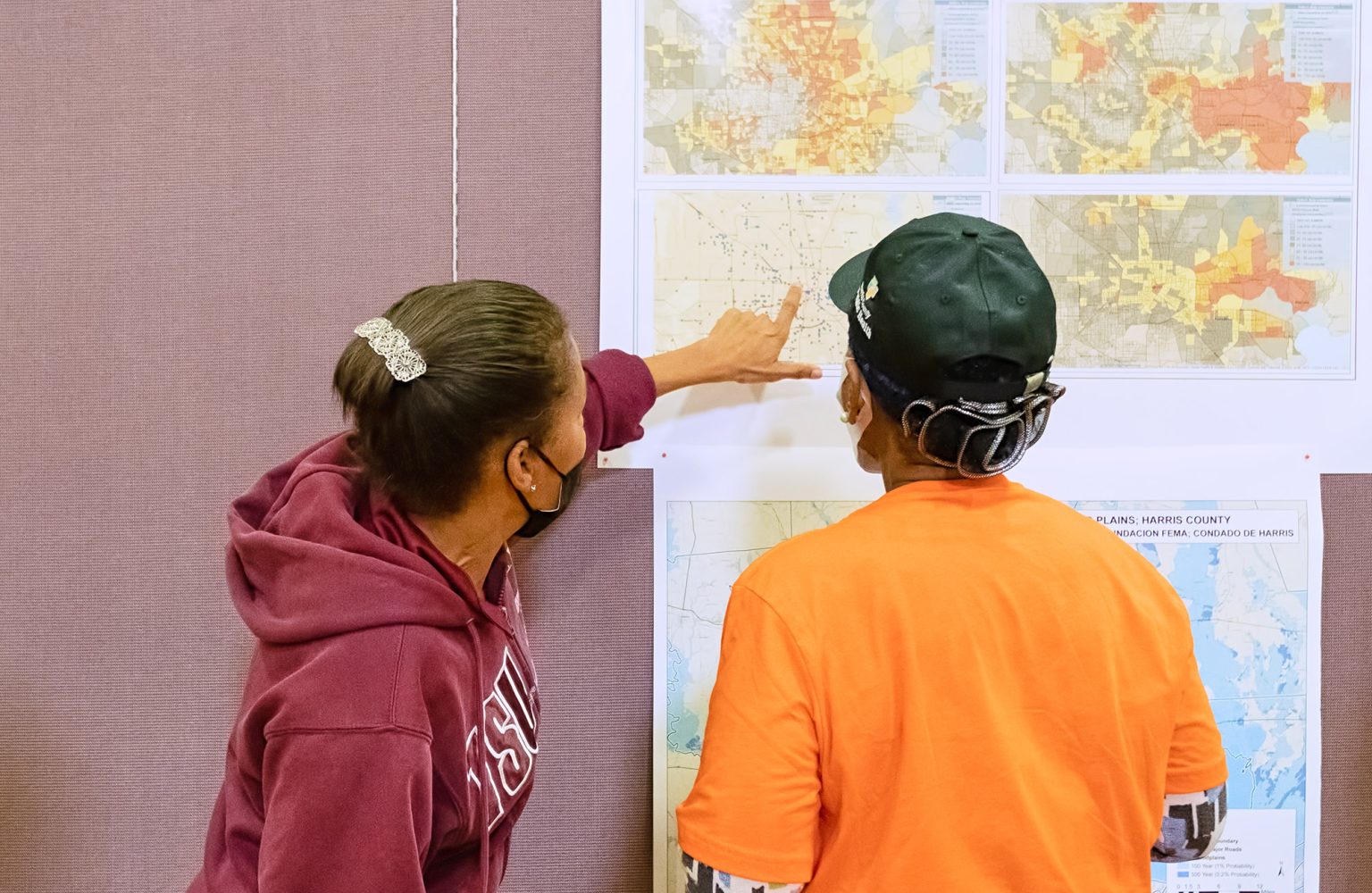
Sheri Smith, Ph.D., associate professor at Texas Southern University and interim chair of the school’s department of Urban Planning and Environmental Policy reviews regional maps with an attendee during the Coalition for Environment, Equity, and Resilience’s People’s Hearing event April 30, 2022, in Houston, Texas.
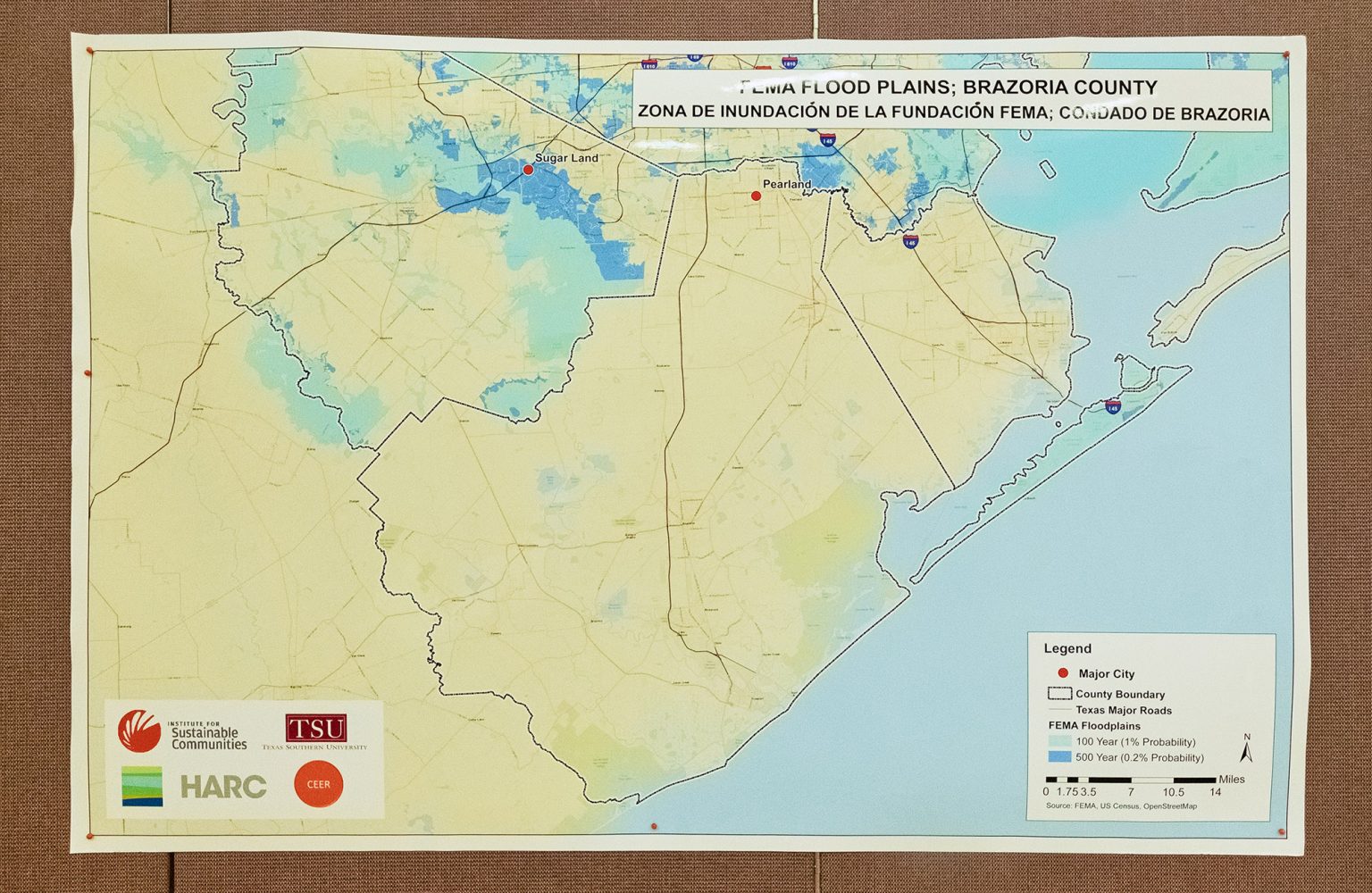
A map from Texas Southern University shows FEMA flood plains in Brazoria County, Texas and hangs on display during CEER’s People’s Hearing event April 30, 2022, in Houston, Texas.

An environmental map from Texas Southern University shows pollution risks in Jefferson County, Texas and hangs on display during CEER’s People’s Hearing event April 30, 2022, in Houston, Texas.
The Institute’s work along the upper Texas Gulf Coast also involved collaboration with the department of urban planning and environmental policy at Texas Southern University, an HBCU (historically Black college or university) in Houston, Texas. The department prepares students to become urban planners and climate professionals.
Everything that we teach — whether they are involved in the community, working with the built environment, working with the natural environment — we do with a social equity lens,” said Sheri Smith, Ph.D., associate professor at Texas Southern University and interim chair of the school’s department of Urban Planning and Environmental Policy.
Together with CEER and the Institute for Sustainable Communities, the department created its Community Environmental Leadership Program, a 12-month graduate certificate program that prepares leaders to tackle environmental justice issues. The program addresses environmental policy, community mapping, flooding, pollution, the history of environmental justice, using data to develop evidence-based arguments, and how to communicate with public officials.
Dr. Smith noted that the programs aim to give participants knowledge and resources for building community resilience and articulating what is happening in their communities.
Centering Equity in Recovery Policies
The Upper Texas Gulf Coast Regional Resilience Initiative noted that when government agencies do not prioritize low-income communities and communities of color, they exclude those most at risk to the effects of climate change.
The initiative gleaned from an inclusive network of community residents, local leaders, academics, community-based organizations, and public decision-makers to recommend policies and practices that government agencies can use to foster an equitable recovery in their communities. The initiative provided the following recommendations that local, state, and federal government agencies:
Local Government Agencies:
- Integrate equity into ordinances, codes and planning processes.
- Coordinate inter-jurisdictional recovery.
- Create an environmental justice task force.
State Government Agencies:
- Mandate statewide updates on flooding maps that are easily accessible to all jurisdictions and communities of impact.
- Enact a moratorium on utility shut-offs and rent evictions during states of disaster.
- Support industries that concurrently boost economies and safeguard communities of color that are near chemical facilities.
Federal Government Agencies:
- Remove barriers to housing assistance, specifically the restrictions placed on the number of times a physical address can receive federal assistance.
- Reconfigure the National Disaster Recovery Framework, which the U.S. Department of Homeland Security developed to address inclusion and equity.
Manuel emphasized that with support from the Institute for Sustainable Communities, the Coalition for Environment, Equity, and Resilience and Texas Southern University worked well together to develop an apparatus that’s creating change in the upper Texas Gulf Coast.
Whether it’s through providing technical assistance so organizations can build their capacity or creating cross-sector partnerships, the Institute continues its works to champion climate equity in communities that are most hard hit by climate change, she said.
“We provide opportunities for cities and communities to leverage the expertise of the members living in those communities — the real-world, real-life lived experience,” Manuel added. “Seeing that as an asset, and not only an asset but essential to any change.”
To learn more about how you can support the Institute’s work to champion climate equity, visit give.sustain.org.
